Let’s explore gas furnace vs. heat pump! When it comes to keeping your home warm and cozy, two primary contenders emerge: the traditional gas furnace and the modern heat pump. These two heating systems employ distinct approaches, each with its own set of advantages and characteristics.
Similar to how hot and cold rolled steel vary in their processing techniques, gas furnaces and heat pumps diverge in their methods of providing secure and efficient heating for your home. To make an informed decision about which heating solution suits your needs best, it is essential to understand the differences that set these two options apart.
Gas Furnace vs Heat Pump: Overview
The choice between a gas furnace and a heat pump involves understanding their unique characteristics and applications. These heating systems offer tailored solutions for creating a comfortable indoor environment, and the decision depends on factors such as climate, efficiency, and personal preferences.
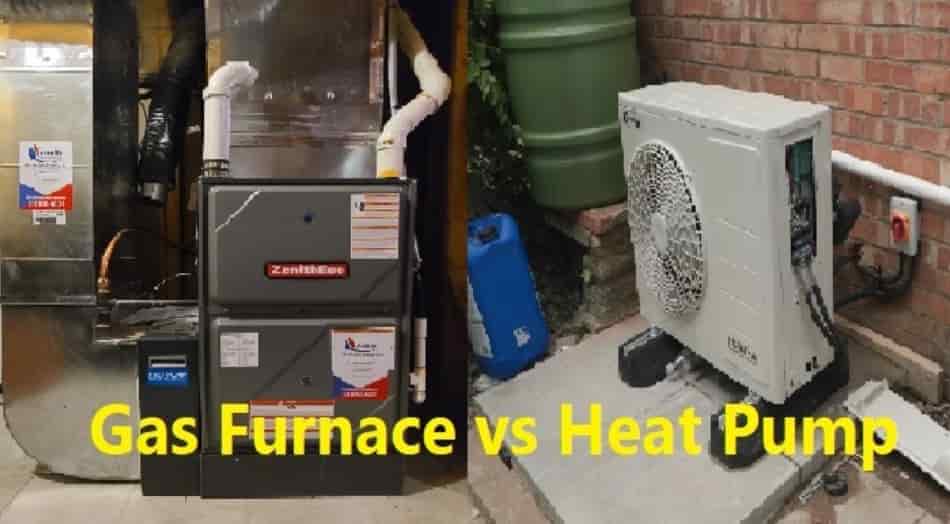
Gas Furnace
- Natural gas or propane is burned to produce heat in a gas furnace.
- It excels in providing rapid and consistent heating, making it well-suited for colder climates.
- Gas furnaces distribute warm air through ductwork, offering precise temperature control.
- They are commonly found in areas with reliable gas supplies and established duct systems.
- While efficient, gas furnaces produce emissions and require proper ventilation.
- They are suitable for those who prioritize quick and powerful heating.
Heat Pump
- A heat pump operates by transferring heat from one location to another, providing both heating and cooling functions.
- It is highly energy-efficient, particularly in regions with moderate climates.
- Heat pumps are ideal for areas with mild winters and summers, as they move heat instead of generating it.
- They offer energy savings and lower operational costs compared to gas furnaces.
- Heat pumps have a smaller environmental footprint, producing fewer emissions.
- They are suitable for those looking for year-round comfort and sustainability.
The decision between a gas furnace and a heat pump is influenced by your location, climate, and environmental goals. Understanding these distinctions is critical for making an informed selection that will keep your house pleasant and efficient throughout the year.
Why to Learn About Gas Furnace and Heat Pump Differences?
There are several reasons why understanding the differences between gas furnaces and heat pumps is important. Firstly, it empowers homeowners and decision-makers to make informed choices when selecting a heating and cooling system for their homes or businesses. Understanding the distinctions in how these systems operate, their efficiency, and their suitability for different climates ensures that individuals can make choices that align with their specific needs and priorities.
Secondly, knowledge of the differences between gas furnaces and heat pumps contributes to energy conservation and environmental sustainability. In an era where climate change and environmental concerns are paramount, selecting the right heating and cooling system can significantly impact energy consumption and greenhouse gas emissions. Being aware of the efficiency and environmental implications of each system allows individuals to make choices that reduce their carbon footprint and contribute to a greener future.
Lastly, learning about these differences is essential for professionals in the HVAC (Heating, Ventilation, and Air Conditioning) industry. HVAC technicians and engineers must have a comprehensive understanding of both gas furnaces and heat pumps to provide expert guidance to clients and ensure the proper installation, maintenance, and repair of these systems. In doing so, they play a critical role in optimizing energy efficiency and comfort for their customers while minimizing environmental impact. Overall, knowledge about the distinctions between these systems benefits individuals, communities, and the planet as a whole.
Gas Furnace and Heat Pump: Working Principle
Understanding the working principles of gas furnaces and heat pumps is essential for grasping how these heating systems function and deliver warmth to your home. Both systems employ distinct mechanisms to generate heat or transfer it from one location to another, and comprehending these principles is key to optimizing their performance.
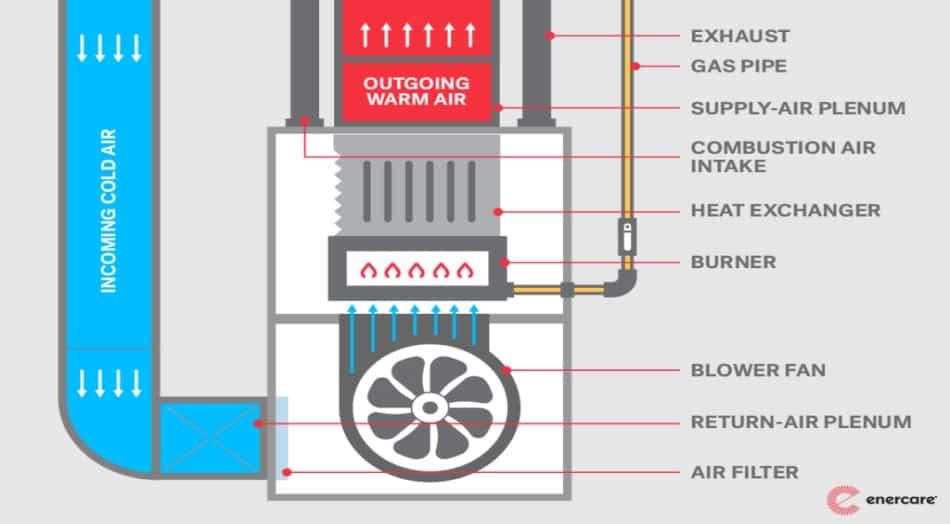
Gas Furnace: Working Principle
- Heat is generated by burning natural gas or propane in a gas furnace.
- The process begins when the thermostat signals a need for warmth.
- In response, the furnace’s gas valve opens, allowing fuel to flow into the burner.
- Simultaneously, an igniter sparks to ignite the gas, producing a flame.
- Air from your home’s return ducts is drawn over a heat exchanger, where it is warmed by the combustion process.
- The heated air is then circulated through the ductwork and into your living spaces via vents or registers, raising the indoor temperature to the desired level.
- Combustion gasses produced during this process are vented safely outside your home through a flue or exhaust pipe.
- Gas furnaces can be controlled by advanced thermostats and systems that allow for precise temperature regulation and programming. This enhances comfort and energy savings by optimizing heating cycles based on your preferences and schedule.
- While traditional gas furnaces rely on a ducted system to distribute heated air, there are also ductless gas furnace options available that provide zoned heating, allowing for greater control and efficiency in specific areas of your home.
Heat Pump: Working Principle
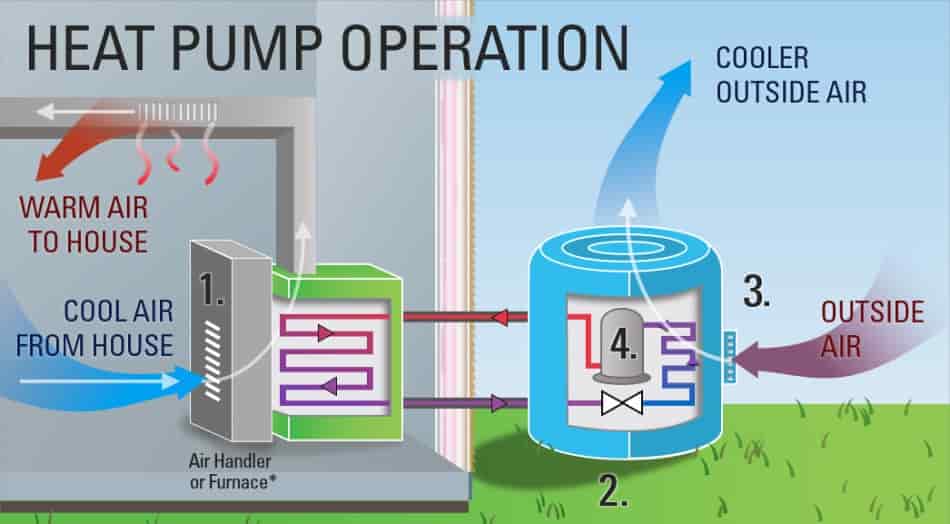
- A heat pump functions by transferring heat from one place to another, rather than generating it through combustion.
- It consists of two main components: an outdoor unit (the condenser) and an indoor unit (the evaporator).
- In heating mode, the outdoor unit extracts heat from the surrounding air, even in cold conditions, and transfers it to the indoor unit.
- A refrigerant, a special fluid with the ability to absorb and release heat, plays a central role.
- The refrigerant circulates between the indoor and outdoor units, absorbing heat at the evaporator coil and releasing it at the condenser coil.
- As the refrigerant releases heat indoors, it warms the air that is then distributed through your home’s ductwork or via a ductless system, raising the indoor temperature.
- Heat pumps can also provide cooling by reversing the process, expelling heat from inside your home to the outdoors in the cooling mode.
- To ensure efficient operation in cold weather, many modern heat pumps are equipped with a supplementary electric heating element known as an auxiliary or backup heat source. This element activates when the outdoor temperature drops significantly, providing additional warmth to maintain indoor comfort.
- By reversing the refrigeration cycle, heat pumps extract heat from inside your home and release it outside. They offer year-round energy efficiency thanks to their dual functionality.
- Some heat pump systems offer ductless options, eliminating the need for ductwork and providing individualized temperature control in different zones or rooms. Ductless mini-split and multi-split systems are popular choices for such applications.
Understanding these working principles is critical for both homeowners and HVAC specialists. It enables efficient operation, maintenance, and troubleshooting of gas furnaces and heat pumps, ensuring that your house is pleasant and energy-efficient all year.
Furthermore, it permits educated selections regarding which system best meets your individual heating and cooling demands, taking climate, energy efficiency, and environmental aspects into account.
Gas Furnace vs. Heat Pump: Which is more efficient?
To thoroughly assess the efficiency of gas furnaces compared to heat pumps, a detailed examination of their characteristics, applications, and performance is essential. By analyzing their distinct strengths and limitations, we can gain a clearer understanding of the suitability of each heating method in various scenarios.
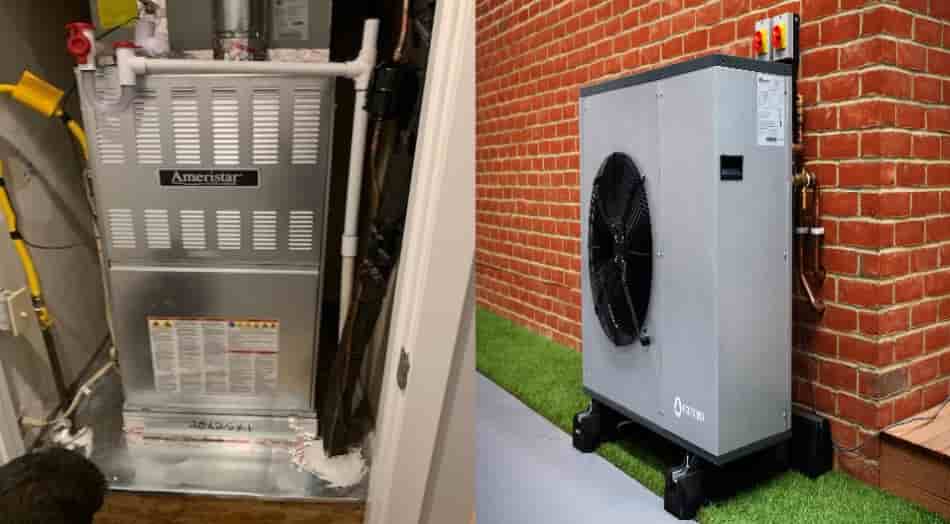
| Efficiency Aspect | Gas Furnace | Heat Pump |
| Heating Source | Gas furnaces use combustion to generate heat, which is highly effective and can rapidly warm a space. | Heat pumps utilize electricity to transfer heat from one location to another, providing efficient heating in moderate climates. |
| Energy Efficiency | Gas furnaces are known for their high energy efficiency, particularly in cold climates, where gas is abundant and cost-effective. | Heat pumps are exceptionally energy-efficient for heating in mild to moderate climates but may require supplementary heating in extremely cold weather. |
| Operational Cost | Gas furnaces can have lower operational costs in regions with affordable natural gas, making them cost-effective for heating during cold winters. | Heat pumps offer lower operational costs in regions with moderate climates, where they can provide both heating and cooling functions. |
| Environmental Impact | Gas furnaces produce greenhouse gas emissions, contributing to environmental concerns, especially if not properly maintained. | Heat pumps produce lower greenhouse gas emissions when using electricity from renewable sources. They offer a more environmentally friendly heating option. |
| Heating Speed | Gas furnaces can provide rapid and high-intensity heating, ideal for quickly warming up a space. | Heat pumps offer consistent heating but may take longer to reach desired temperatures, particularly in extremely cold conditions. |
| Versatility | Gas furnaces are primarily designed for heating and may require a separate cooling system. | Heat pumps provide both heating and cooling functions, offering year-round comfort and versatility. |
| Maintenance | Gas furnaces require regular maintenance, including cleaning, filter replacement, and safety checks. | Heat pumps also require maintenance but tend to be less complex, with fewer combustion-related components. |
| Initial Cost | Gas furnaces typically have a lower upfront cost compared to heat pumps. | Heat pumps often have a higher initial cost, but they can provide long-term energy savings. |
| Long-Term Efficiency | Gas furnaces can remain efficient with proper maintenance but may be less efficient in extremely cold conditions. | Heat pumps maintain their efficiency in moderate climates but may require backup heating in colder regions. |
| Noise Level | Gas furnaces can be relatively noisy due to the combustion process and air distribution. | Heat pumps are generally quieter during operation, making them suitable for residential areas. |
This comprehensive table meticulously dissects the efficiency aspects associated with gas furnaces and heat pumps, covering factors such as heating source, energy efficiency, operational costs, environmental impact, heating speed, versatility, maintenance, initial cost, long-term efficiency, and noise level.
Efficiency Considerations
Heating Source and Energy Efficiency: Gas furnaces excel in rapidly heating spaces, especially in colder climates with access to affordable natural gas. Heat pumps offer energy-efficient heating in moderate climates but may require supplementary heating in extreme cold.
Impact on the environment and operational costs
Gas furnaces can have lower operational costs in regions with abundant and affordable natural gas but may contribute to greenhouse gas emissions. Heat pumps offer lower operational costs in moderate climates and a more environmentally friendly heating option.
Versatility and Long-Term Efficiency
Gas furnaces are designed primarily for heating and may require separate cooling systems. Heat pumps provide both heating and cooling functions, offering year-round versatility and efficiency.
Initial Cost and Maintenance
Gas furnaces generally have a lower upfront cost, while heat pumps may have a higher initial investment. Maintenance requirements differ, with gas furnaces needing more frequent checks and cleaning.
Heating Speed and Noise Level
Gas furnaces provide rapid heating but can be relatively noisy. Heat pumps offer consistent heating and are generally quieter during operation, suitable for residential areas.
In assessing which heating method is more efficient, it is crucial to consider your climate, energy costs, environmental concerns, and the year-round versatility you require for your heating and cooling needs.
Gas Furnace vs. Heat Pump: Which is more Costly?
When deciding between a gas furnace and a heat pump for your heating needs, it’s essential to weigh their relative costs and benefits. Initial expenses can differ, but the long-term implications can significantly impact your overall investment.
| Aspect | Gas Furnace | Heat Pump |
| Initial Equipment Costs | Moderate (Equipment: $2,500-$6,000+) | Higher (Equipment: $3,500-$8,000+) |
| Operating Costs | Higher (Gas consumption costs) | Lower (Electricity consumption costs) |
| Maintenance Costs | Moderate | Moderate |
| Long-term Efficiency | Moderate (Efficiency varies with fuel costs) | Higher (Consistent efficiency) |
| Environmental Impact | Lower (Carbon emissions) | Higher (Electricity generation) |
| Life Expectancy | 15-30 years | 15-20 years |
When it comes to deciding between a gas furnace and a heat pump, it’s essential to consider the cost-related factors. Both systems have their advantages and disadvantages, so a careful evaluation based on your specific needs and budget is crucial.
Gas furnaces typically come with moderate initial equipment costs, ranging from approximately $2,500 to $6,000 or even more, depending on various factors. However, they tend to have higher operating costs because they rely on natural gas consumption. Maintenance expenses for gas furnaces are generally moderate, and their long-term efficiency can fluctuate with changing fuel costs. On the environmental front, gas furnaces have a relatively lower impact in terms of carbon emissions. Moreover, they often have a longer life expectancy, typically falling within the range of 15 to 30 years.
In contrast, heat pumps usually involve higher upfront equipment costs, typically ranging from $3,500 to $8,000 or more, depending on the model and installation requirements. However, they offer the advantage of lower operating costs since they primarily rely on electricity. Maintenance costs for heat pumps are typically moderate as well, and they provide consistent long-term efficiency. On the environmental side, heat pumps tend to have a higher impact due to electricity generation. Their life expectancy is generally shorter, falling in the range of 15 to 20 years.
Differences between Gas Furnace and Heat Pump
When it comes to selecting a heating system for your home, understanding the differences between a gas furnace and a heat pump is crucial. These two heating options have distinct characteristics that can significantly impact your comfort, energy efficiency, and operating costs. Here’s a comprehensive comparison of the disparities between a gas furnace and a heat pump:
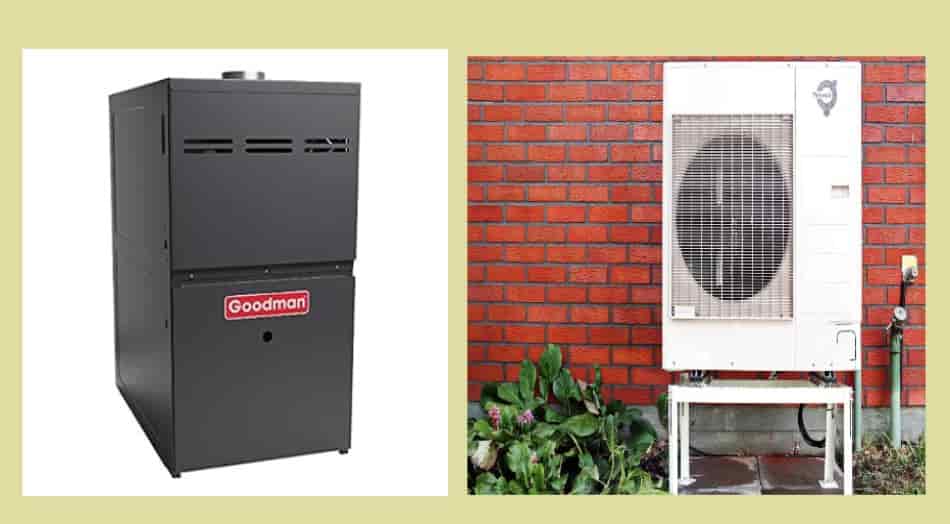
| Aspect | Gas Furnace | Heat Pump |
| Heating Mechanism | Generates heat by burning natural gas or propane | Transfers heat from outside air or ground to the inside |
| Energy Source | Relies on fossil fuels like natural gas or propane | Primarily uses electricity as an energy source |
| Efficiency | Typically highly efficient, especially in cold climates | Highly efficient in moderate climates, less so in cold |
| Cooling Capability | Does not provide cooling; requires a separate AC unit | Provides both heating and cooling in a single unit |
| Environmental Impact | Produces carbon emissions due to fossil fuel combustion | More environmentally friendly with lower emissions |
| Installation Costs | Installation can be complex and potentially expensive | Generally easier and less expensive to install |
| Operating Costs | Lower operating costs in areas with affordable gas | Lower operating costs in regions with mild winters |
| Longevity | Longer lifespan, often 15-30 years with maintenance | Shorter lifespan, typically 15-20 years with maintenance |
| Overall Suitability | Well-suited for cold climates with available gas | Ideal for moderate climates with efficient year-round |
This table summarizes the fundamental differences between a gas furnace and a heat pump to help you evaluate these heating and cooling systems for your unique needs.
Gas Furnace vs. Heat Pump: Pros & Cons
Gas Furnace
| Pros | Cons |
| Efficient heating in cold climates | Operates using fossil fuels, contributing to carbon emissions |
| Provides rapid and effective heating | No cooling function (heating-only) |
| Longer lifespan (typically up to 30 years) | Higher operating costs due to fuel consumption |
| Cost-efficient in very cold climates | Potential carbon monoxide risk if not properly maintained |
| Proven technology with reliability | Requires a chimney or venting system |
| Widely available and easy to install | Higher installation costs in some cases |
| Performs well in extreme cold conditions | Less efficient and cost-effective in milder climates |
| Compatible with existing ductwork | Noise and air quality issues in poorly maintained units |
Heat Pump
| Pros | Cons |
| Provides both heating and cooling functions | May struggle in extremely cold climates |
| Generally energy-efficient | May require a backup heat source in very cold areas |
| Lower carbon emissions compared to gas furnaces | Initial installation costs can be higher |
| All-in-one solution for year-round comfort | Electric-powered, leading to higher electricity bills |
| Operates quietly, especially the indoor unit | May require additional ductwork or modifications |
| No carbon monoxide risk associated with fuel combustion | Maintenance costs can add up over time |
| Compatible with various home heating and cooling systems | Performance can be affected by extreme temperatures |
| Environmentally friendly refrigerants | May have a shorter lifespan than gas furnaces |
| Can dehumidify indoor air during cooling mode | Defrost cycles can affect efficiency in cold weather |
| Potential for local utility rebates and incentives | Initial cost can be a barrier for some homeowners |
Which One Should You Choose – Gas Furnace or Heat Pump?
Choosing between a Gas Furnace and a Heat Pump depends on several key factors. If you live in a cold climate with harsh winters, a Gas Furnace may be the better choice, as it offers rapid and reliable heating. Additionally, if your home is already equipped with natural gas lines, opting for a Gas Furnace can be cost-effective. Gas furnaces have a proven track record of dependable performance and can quickly raise the indoor temperature during cold spells.
On the other hand, a Heat Pump is a versatile option if you value year-round comfort. Heat pumps provide both heating and cooling functions, making them suitable for all seasons. They are also more energy-efficient, potentially leading to lower utility bills, and are well-suited for mild to moderate climates. If you prioritize quiet operation and reducing carbon emissions, a Heat Pump can be an attractive choice. Additionally, many utility companies and government programs offer incentives for installing energy-efficient heat pumps, making them a cost-effective and environmentally friendly option.
FAQs
What sets a gas furnace apart from a heat pump in terms of operation?
A gas furnace generates heat by burning natural gas or propane, providing rapid and powerful heating. In contrast, a heat pump transfers heat from one location to another, offering both heating and cooling functions.
Which system is more energy-efficient, a gas furnace or a heat pump?
The energy efficiency of a gas furnace is notable in cold climates with access to affordable gas. On the other hand, heat pumps are generally energy-efficient in moderate climates but may require backup heating in extreme cold.
Which system is better suited for year-round comfort and versatility?
Heat pumps provide both heating and cooling functions, making them an all-in-one solution for year-round comfort. They are particularly well-suited for moderate climates, offering versatility in maintaining indoor comfort throughout the year.
Conclusion
In conclusion, the choice between a Gas Furnace and a Heat Pump is a decision that hinges on several factors. Gas furnaces excel in delivering swift and reliable heating, making them ideal for cold climates. They have a longer lifespan but come with higher operating costs and environmental considerations due to emissions. However, they lack cooling capabilities.
On the other hand, Heat Pumps offer year-round comfort due to their heating and cooling features. They are energy-efficient, environmentally friendly, and operate quietly. Heat pumps shine in moderate climates, reducing utility bills. Yet, they might struggle in extreme cold and have higher initial costs.

